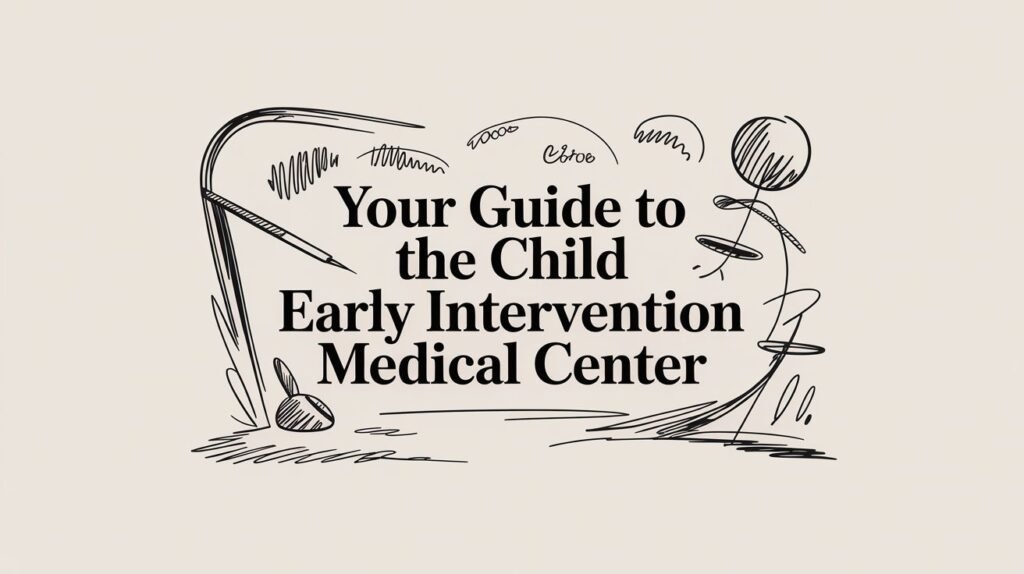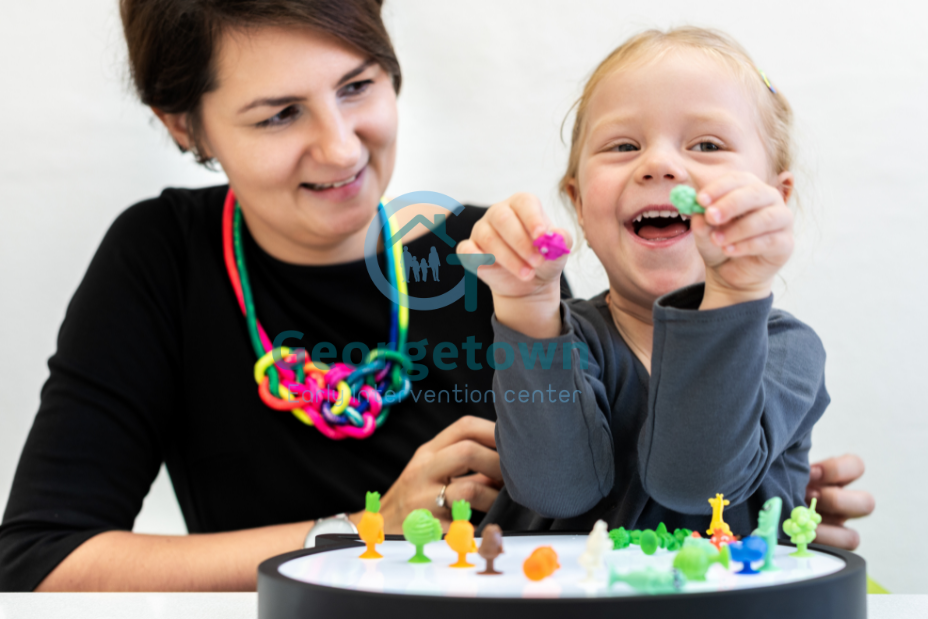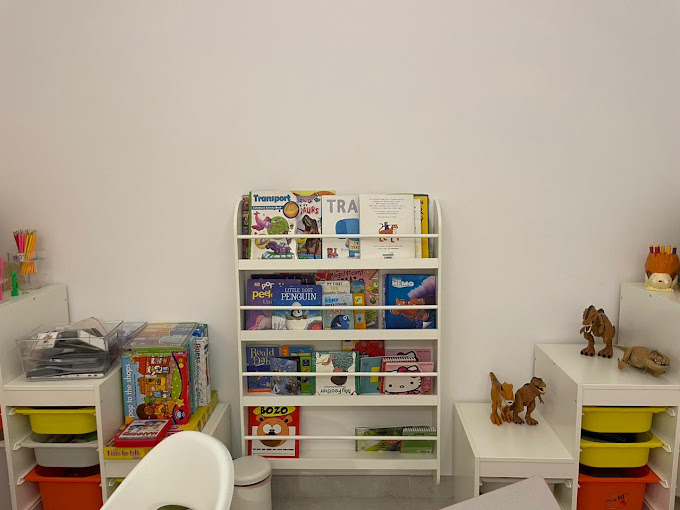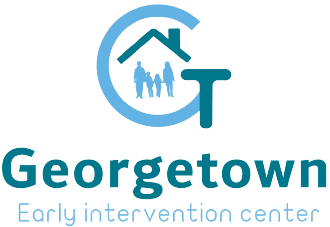When you first hear the term "early intervention center," it might sound a bit clinical, maybe even a little intimidating. Let's pull back the curtain on what these places are really all about. At its core, a child early intervention medical center is a hub of support and nurturing, designed to give young children the best possible start in life.
Think of it like a dedicated gardener tending to a young seedling. The gardener knows this early stage is absolutely critical. They provide just the right soil, the perfect amount of sunlight, and consistent care—not just to help the seedling grow, but to ensure it develops strong roots and can one day flourish on its own.
An early intervention center does something similar for a child during their most formative years. A young child's brain has an incredible capacity for learning and change, and these centers are designed to make the most of this precious window of opportunity.
Unlocking Potential Inside an Early Intervention Centre

So, what actually happens inside one of these centers? It’s far from the sterile, one-size-fits-all environment you might be picturing.
A Hub of Specialized Support
Instead of a single approach, these centers bring together a whole team of specialists—think speech therapists, occupational therapists, and child psychologists—who all collaborate on your child's development. This integrated team creates a supportive ecosystem where progress in one area often sparks growth in another. The mission is simple but profound: to identify developmental delays early and provide effective, evidence-based therapies to address them.
This isn't about "fixing" a problem. It’s about truly understanding a child's unique strengths and challenges to build a personalized roadmap for their success. This roadmap almost always includes a blend of different services designed to work together in harmony.
The goal is to move beyond clinical definitions and focus on what these centers are truly about: nurturing a child’s unique potential in a supportive, expert environment. It’s a partnership between therapists, the child, and the family.
What Does This Support Look Like?
Most of the therapies and activities inside a child early intervention medical center are play-based, which makes learning feel natural and engaging for a young child. At the heart of it all are programs built around the top developmental activities for infants that are known to boost cognitive and motor skills.
This might look like:
- Structured Play: Using fun games to teach crucial social skills like sharing, waiting, and taking turns.
- Sensory Activities: Engaging with different textures, sounds, and movements to help with sensory processing and regulation.
- Guided Learning: Breaking down complex tasks, like getting dressed or brushing teeth, into small, manageable steps that build confidence.
Ultimately, everything that happens inside the center is focused on empowering your child. It's about building their confidence, improving their ability to communicate and interact with the world around them, and equipping them with the foundational skills they need for school and for life. It’s a proactive, hopeful, and deeply personal journey.
Why Early Support Is So Critical
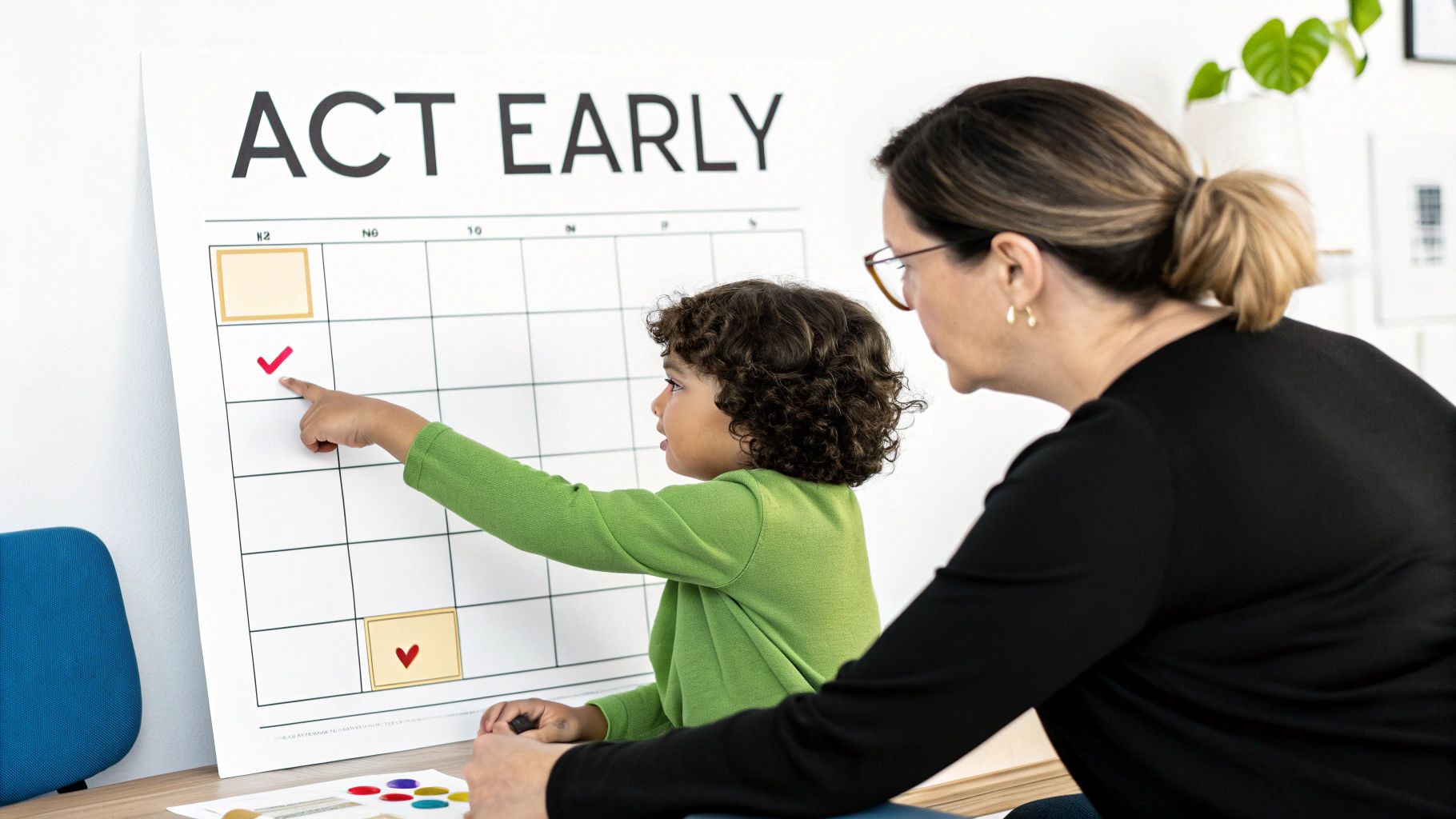
To really grasp the power of early intervention, it helps to understand why timing is everything in a child's development. The window from birth to age five is a period of incredible brain growth, a time when the bedrock for future learning, behavior, and health is laid down for life. This isn’t a slow, quiet process—it's a dynamic explosion of connection-building.
The Power of Neuroplasticity
At the heart of this developmental magic is a concept called neuroplasticity. Think of a young child's brain like a brand-new city under construction. In these early years, roads and pathways are being paved at a lightning pace, connecting different neighborhoods (or areas of the brain) to allow for communication and function.
Every time a child learns a new skill, like stacking a block or saying a word, a new neural pathway is formed. The more they practice, the stronger and faster that pathway becomes, much like a dirt track is eventually paved into a superhighway. A child early intervention medical centre acts like an expert team of city planners and engineers during this crucial construction phase.
Therapists work to reinforce essential pathways and help forge new ones where there might be a delay or a roadblock. By providing targeted support during this peak period of neuroplasticity, we can help the brain adapt and build strong, lasting connections that would be much harder to create later on.
The science is clear: the first few years of a child's life represent a crucial window of opportunity. Intervening early doesn't just address a current challenge; it fundamentally shapes a child's developmental trajectory for years to come.
This period is when therapeutic support can make a profound and lasting impact. It’s the very reason why acting on your concerns, no matter how small they seem, is so important for your child's long-term well-being and success.
Addressing Regional Needs and Disparities
This sense of urgency isn't just a scientific principle; it's a pressing real-world need, especially here in our region. Across the United Arab Emirates and the wider MENA region, unique demographic trends and health factors make early childhood support a critical priority.
There are over 100 million children aged 0-8 in the MENA region, but access to high-quality developmental care can be uneven. Disparities in essential services, like antenatal care, directly influence developmental outcomes and highlight the gaps many families face. These challenges are often magnified for children with functional disabilities or those from lower-income backgrounds, who are at a higher risk for delays. To understand more about these regional dynamics, you can explore the full ECD overview for the MENA region.
Empowering Parents to Act
Recognizing the need for intervention isn't about creating alarm or focusing on deficits. Far from it. It's about empowerment. It’s about giving you, as a parent, the tools and knowledge to make the most of this critical time in your child's life.
Keep these key points in mind:
- Early identification leads to better outcomes. The sooner a developmental delay is spotted, the more effective therapeutic support can be.
- Support builds a strong foundation. Intervention helps develop core skills in communication, social interaction, and emotional regulation—all essential for school readiness and future learning.
- It benefits the whole family. These centres also provide parents with strategies and support, which helps create a more confident and effective home environment for everyone.
By seeking support from a child early intervention medical centre, you’re not just addressing a specific concern; you are investing in your child's future resilience, confidence, and ability to thrive. You can learn more about the importance of early intervention in child development in our related article. This proactive step helps pave the way for a brighter, more successful future.
Understanding The Core Therapeutic Services
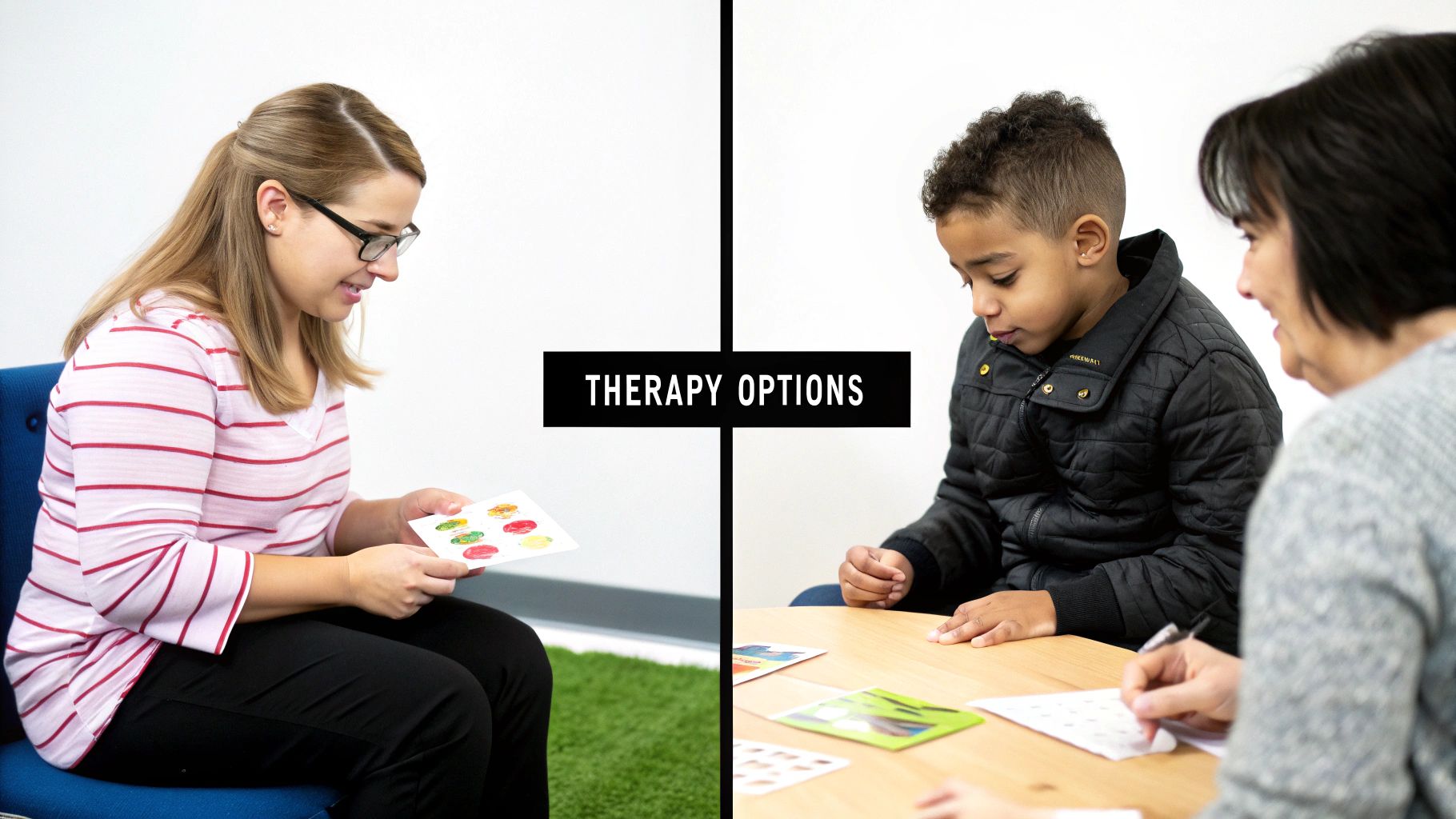
When you first step into a child early intervention medical centre, you're entering a world of specialized support designed to help your child flourish. It helps to think of each service as a different tool in a toolbox, carefully chosen to build specific skills. Let's peel back the clinical jargon and look at what these core therapies actually do.
It’s important to remember these therapies aren’t separate islands. They often overlap and support one another, creating a strong foundation for your child's growth. When a child makes progress in one area, it often sparks gains in another, building a powerful cycle of learning and confidence.
Occupational Therapy Building Everyday Skills
Occupational Therapy, or OT, is all about helping children succeed in the "occupations" of daily life. For a child, that means playing, learning, and simply growing up. An occupational therapist is like a personal coach who helps your child master the physical and sensory skills needed to navigate their world with more confidence and independence.
This therapy is incredibly practical. An OT session might focus on improving fine motor skills, like learning to hold a crayon correctly, button up a shirt, or use a fork at mealtime. It's about breaking down these everyday tasks into small, achievable steps, turning challenges into successes.
OTs also focus heavily on sensory processing. Many children struggle with sensitivities to things like loud noises, certain food textures, or bright lights. An occupational therapist can create strategies to help them manage these feelings, making their environment feel safer and more predictable so they can better engage with the world around them.
Speech and Language Therapy Finding Their Voice
Speech and Language Therapy is about so much more than just pronouncing words. It covers the entire world of communication—understanding what others are saying and being able to express their own thoughts clearly. A speech-language pathologist (SLP) acts as a communication guide for your child.
The work of an SLP usually falls into two main areas:
- Expressive Language: This is all about helping children use words and sentences to share what they’re thinking and feeling. It could mean working on specific sounds, building their vocabulary, or learning how to string a sentence together.
- Receptive Language: This side of things is about understanding. An SLP might use activities to help a child follow directions, understand questions, or pick up on the non-verbal cues that are so important in a conversation.
For many children, this therapy is what unlocks their ability to connect with family and friends, reducing frustration and building stronger social bonds.
Applied Behaviour Analysis Fostering Positive Change
Applied Behaviour Analysis (ABA) is one of the most well-researched and structured approaches in early intervention. At its heart, ABA uses positive reinforcement to help build useful skills and reduce challenging behaviors. It’s a systematic method grounded in the science of how we learn.
Think about teaching a child to ask for a toy instead of grabbing it. An ABA therapist would break this down, show the child how to ask, and then offer immediate praise or a small reward when they use their words. This positive feedback makes it more likely the child will use that new skill again.
ABA therapy isn't about changing a child's personality. It's a tool that empowers them with the communication, social, and learning skills they need to participate more fully and successfully in their world.
This approach is tailored to each child’s specific needs and goals. You can get a better sense of how this works by exploring some common strategies of therapy used in early intervention and seeing how different methods are applied.
Child Psychology Nurturing Emotional Well-being
While other therapies concentrate on specific skills, child psychology looks at the emotional and behavioral health of the child and their family. A child psychologist helps children learn to understand and manage their big feelings, develop healthy ways to cope with stress, and improve how they interact with others.
This kind of support is critical, because learning to regulate emotions is a cornerstone of healthy development. A session might use play-based activities to help a child express their feelings or involve working with parents to find effective ways to manage difficult behaviors at home.
The need for these integrated services is especially clear across the MENA region. Data shows that only about 27% of children aged 3 to 5 are enrolled in pre-school programs, creating a gap in crucial early development. This highlights just how vital a child early intervention medical centre can be in providing that foundational support.
The therapies we've discussed each play a unique role, but they often work best when they work together. Here's a quick summary to help you see how they fit.
Key Therapies in Early Intervention
| Therapy Type | Main Focus Area | Example Skills Addressed |
|---|---|---|
| Occupational Therapy | Daily living and sensory skills | Holding a pencil, getting dressed, managing sensory sensitivities |
| Speech & Language Therapy | Communication | Pronouncing words, building vocabulary, understanding directions |
| Applied Behaviour Analysis | Behavior and learning | Asking for help, social turn-taking, reducing challenging behaviors |
| Child Psychology | Emotional and social health | Managing big emotions, coping with anxiety, social problem-solving |
Ultimately, these core services create a comprehensive support system for your child. Parents can also find wonderful resources to use at home, like books focused on children's emotions, to continue building on the progress made in therapy. It's all about empowering your child to thrive.
The Lasting Impact of Integrated Care

Early intervention isn't just about managing today's challenges; it's about laying down the groundwork for a rich, independent life. The true magic of a child early intervention medical centre is its integrated care model, which sends out positive ripples into every corner of a child's future.
Think about building a house. You wouldn’t want the plumber, electrician, and carpenter working in silos, never speaking to one another. For the best outcome, they need to communicate and align their plans. That same collaborative spirit is what makes an integrated care team so effective.
When occupational therapists, speech pathologists, and psychologists share their insights and work toward common goals, they build a powerful, unified support system for your child. Progress in one area often sparks growth in another, creating deeper, more sustainable results.
Building Skills for School and Beyond
One of the most immediate benefits of integrated care is better school readiness. The skills nurtured at an intervention center transfer directly into the classroom, setting children up for both academic and social success from day one.
And this goes far beyond just learning letters and numbers. It’s about strengthening the core abilities that make learning possible in the first place:
- Attention and Focus: Therapies help lengthen a child's ability to concentrate, tune out distractions, and follow a teacher's instructions.
- Social Communication: Kids learn the essentials of getting along with peers—how to take turns, share toys, and read social cues during playtime.
- Emotional Regulation: A child psychologist can provide tools to help children manage big feelings, reducing the kind of frustration that can get in the way of learning.
- Fine Motor Skills: Occupational therapy builds the hand strength and dexterity needed for writing, drawing, and confidently using classroom tools.
With these foundational skills in place, children feel more confident and ready to participate. They're better prepared to make friends, connect with their teachers, and approach learning with curiosity instead of anxiety.
Fostering Confidence and Independence
Looking past the classroom, the ultimate goal of a child early intervention medical centre is to nurture independence in every part of daily life. As therapists work together, they help children master the everyday tasks many of us take for granted, building up their self-esteem with every small victory.
Take a child who finds getting dressed to be a sensory nightmare. An occupational therapist might introduce sensory strategies to make clothing feel more comfortable, while a behavior therapist uses positive reinforcement to make the morning routine a source of pride, not conflict. This teamwork turns a daily struggle into a moment of success.
A child’s newfound ability to communicate their needs, manage their emotions, and complete tasks on their own is not just a milestone. It is the building block of a resilient and self-assured individual who believes in their own capabilities.
This growing independence completely opens up a child's world. It empowers them to try new activities, handle social situations with greater ease, and see themselves as capable and strong.
Supporting the Entire Family Unit
Great early intervention recognizes that a child's progress is deeply intertwined with their family's well-being. A truly integrated center wraps its support around parents and caregivers, too, giving them the knowledge and tools to carry the momentum forward at home.
This family-first approach creates a nurturing environment that benefits everyone. Parents learn practical communication techniques, strategies for managing difficult behaviors, and simple ways to adapt their home to fit their child's needs. This partnership is what makes the progress stick.
Initiatives like Ahlan Simsim across the MENA region show just how powerful this model can be. By offering comprehensive health services, psychosocial support, and caregiver education, these programs demonstrate how integrated services can lift entire communities, especially those impacted by crisis. As the International Rescue Committee has highlighted, investing in early childhood development provides immense social and economic benefits. You can discover more about these innovative solutions in the MENA region and see how this approach empowers families and strengthens communities from the ground up.
How to Choose the Right Center for Your Child
Making the decision to seek support is a huge step, and finding the right child early intervention medical center for your family can feel like the next big hurdle. But think of this process as finding a true partner for your family's journey. Your goal is to find a place where both you and your child feel seen, heard, and completely supported.
It’s a lot like choosing a school for your little one. You wouldn't just pick one from a list; you’d visit, talk to the team, and get a feel for the environment. The same thoughtful approach is essential here. You're looking for a center whose philosophy aligns with your family’s values and whose team you can genuinely trust.
Start with the Credentials and Expertise
Before you get into the feel and fit of a center, it’s critical to confirm the team’s qualifications. The therapists and specialists are the heart of any program, and their expertise will directly shape your child's experience and progress. This is the foundation upon which everything else is built.
Make sure to verify that all therapists hold the necessary licenses and certifications for their respective fields here in the UAE. This isn't just a formality—it's your assurance that they have met rigorous professional standards. Don't be shy about asking for their specific experience with children who have needs similar to your own.
Here’s a quick checklist of what to look for:
- Licensed Professionals: Ensure psychologists, speech therapists, and occupational therapists are fully licensed and in good standing.
- Specialized Training: Ask about any advanced certifications, especially in areas relevant to your child, like sensory integration for OTs or specific communication methods for SLPs.
- Team Collaboration: How do the different therapists work together? A center that promotes regular team meetings to discuss your child's progress is a very positive sign of a holistic approach.
A great center will be proud of its team and completely transparent about their credentials. This initial check gives you the confidence that your child will be in skilled, capable hands.
Understand Their Therapeutic Philosophy
Once you've confirmed the team is qualified, the next step is to understand how they approach their work. Every child early intervention medical center has a guiding philosophy. Some may follow a very structured, data-driven model, while others might favor a more play-based, child-led approach.
There isn't a single "best" philosophy. The right one is what resonates with your family and, most importantly, fits your child's unique personality and needs. Asking about this early on helps ensure everyone is working toward the same vision of success for your child.
The most effective therapeutic relationships are built on a shared understanding of goals and methods. It’s crucial to find a center whose approach not only makes sense to you but also feels like a natural and positive fit for your child.
For instance, you'll want to ask how they create individualized therapy plans. A key strength of centers like Georgetown is the deep commitment to creating a unique plan for every single child, recognizing that a one-size-fits-all approach just doesn't work.
Evaluate the Assessment Process
The very first step on your child's therapy journey will be an initial assessment. This is where the team gets to know your child's unique strengths and challenges. A thorough, respectful, and family-centered assessment process is a hallmark of a high-quality center.
Ask specific questions about how this works:
- Who is involved? Will you get to speak with multiple specialists, or just one intake coordinator?
- What does it entail? Will it involve formal testing, structured observation, or play-based activities? A good assessment often uses a mix of all three.
- How are parents included? You are the expert on your child. The center should value your insights and observations as a critical part of the assessment.
A rushed or impersonal assessment can lead to a therapy plan that doesn't fully capture what your child needs. Look for a center that takes its time to truly understand your child from every angle. For example, if your primary concern is communication, understanding how different specialists contribute is vital. For more guidance, our article on choosing the right language therapist in the UAE provides deeper insights into what to look for in a speech pathology assessment.
Choosing the right center is a major decision, and having a clear set of criteria can make the process feel much more manageable. Use this checklist to guide your conversations and observations as you visit different facilities.
Evaluation Checklist for Early Intervention Centres
| Evaluation Criteria | Key Questions to Ask | What to Look For |
|---|---|---|
| Team Qualifications | Are all therapists licensed in the UAE? What specialized training or certifications do they hold? | Look for transparency and a willingness to share credentials. Experienced, certified professionals are a must. |
| Therapeutic Approach | What is your center's core philosophy? How do you create and adapt individual therapy plans? | A clear, consistent philosophy that aligns with your family's values. Evidence of personalized, not cookie-cutter, plans. |
| Assessment Process | Can you walk me through your initial assessment? How are parents involved in this process? | A comprehensive, multi-faceted process that includes parent input. A team that listens and is genuinely curious about your child. |
| Environment & Facilities | Is the space clean, safe, and welcoming? Are the therapy rooms well-equipped for different needs? | A child-friendly atmosphere that feels both professional and comforting. Equipment should be modern and appropriate for therapy. |
| Parent Communication | How will I be updated on my child's progress? Are there opportunities for parent training or involvement? | Regular, clear communication channels (e.g., reports, meetings). A center that sees parents as essential partners in the process. |
| Logistics & Practicality | What are your hours? Do you accept our insurance? What is the policy for rescheduling? | Practical details that fit your family's life. A clear and transparent billing and scheduling process to avoid future stress. |
This checklist isn't just about ticking boxes; it's about finding the place where your family feels the most confident and supported for the journey ahead.
Consider the Practical Details
Finally, don't overlook the practical side of things. The best program in the world won't be effective if it's too difficult for your family to access consistently. Consistency is absolutely key to making progress in early intervention, so these logistical factors matter a great deal.
Think about these points:
- Location and Accessibility: Is the center reasonably easy to get to? Consider traffic and parking to avoid adding unnecessary stress to your day.
- Scheduling Flexibility: Do their hours work with your family's schedule? Do they offer any flexibility if you need to reschedule an appointment?
- Insurance and Payment: Be sure to clarify which insurance plans they accept and what your out-of-pocket costs will be. A transparent billing department is a must.
- Parent Involvement: How does the center communicate progress? Do they offer parent training sessions or chances to observe therapy?
By carefully weighing both the professional expertise and the practical fit, you can confidently choose a child early intervention medical center that will become a trusted and invaluable partner in your child’s development.
Your Questions About Early Intervention, Answered
Stepping into the world of early intervention can feel like learning a whole new language. It’s a journey you didn't plan for, and it's completely normal to have a long list of questions and feel a bit uncertain.
We've put together this section to offer clear, compassionate answers to some of the most common concerns we hear from parents. Think of this as the start of a conversation, a way to replace some of that doubt with confidence as you move forward.
What Are the First Signs My Child Might Need Support?
This is often the first question on a parent's mind: "How do I know if this is a real concern?" While it's true that every child develops at their own unique pace, there are some general developmental milestones that act as helpful signposts. If your child is consistently missing several of these milestones, or if you notice a regression in skills they once had, it might be a sign that a little extra support could make a big difference.
Here are a few key areas to keep an eye on:
- Social and Emotional Milestones: By their first birthday, does your child respond when you call their name? Are they engaging in simple back-and-forth games like peek-a-boo?
- Language and Communication: Is your toddler using single words by 16-18 months and starting to string two words together by age two? Do they point to things to show you what they want or what they're interested in?
- Cognitive Milestones: Does your child seem curious about the world around them? Do they explore objects with their hands and mouth, or can they follow simple, age-appropriate directions?
- Movement and Physical Development: Are they hitting those big motor milestones like sitting up, crawling, and walking within the generally expected timeframes?
Seeing a delay in just one area isn't necessarily a cause for alarm, but it is a perfect reason to seek a professional opinion. Trusting your gut is often the most powerful first step you can take.
What Happens During the Initial Assessment?
The word "assessment" can sound so formal and clinical, but in reality, it's just the first step in getting to know your unique child. A high-quality child early intervention medical center will ensure this process feels warm, welcoming, and, most importantly, centered around play. The goal isn’t to test your child, but to get a complete picture of their strengths and the areas where they could use a boost.
The process usually breaks down into a few parts:
- Parent Interview: This is your time to talk. You’ll share your observations, your concerns, and what you hope to achieve. You know your child better than anyone, and your insights are the most valuable part of this entire process.
- Play-Based Observation: The therapists will simply play with your child. In this natural, fun setting, they can see firsthand how your child communicates, moves, solves problems, and interacts with the world.
- Standardized Evaluations: Depending on your specific concerns, the team might use some formal tools. These are just ways to see how your child’s skills compare to typical developmental patterns for their age.
This initial meeting is a collaboration. It’s a chance for you to ask every question you have and for the team to see your child as a whole person, not just a list of challenges.
An assessment isn’t a test for your child to pass or fail. It’s a compassionate discovery process, designed to build a personalized support plan that truly fits their specific needs.
How Involved Will I Be in My Child’s Therapy?
Your role isn't just important—it's everything. Modern early intervention is built on a family-centered model, which means you are a core member of the therapy team. The real magic doesn't just happen in the therapy room; it happens when the skills learned there are carried over into your child's everyday life. And you are the key to making that happen.
Your involvement might look different from one week to the next, but it generally includes:
- Participating in Sessions: Many therapists will invite you to join in, so you can learn the strategies they’re using and see them in action.
- Setting Goals: You’ll work side-by-side with the therapists to set goals that are meaningful for your child and align with your family’s priorities.
- Home Practice: You won't be sent home with a list of chores. Instead, you'll get simple, practical activities you can weave right into your daily routines—like bathtime, meals, or playtime—to reinforce what your child is learning.
This partnership is what makes the progress stick. You're not just a spectator in this process; you are your child's most powerful advocate, teacher, and cheerleader.

